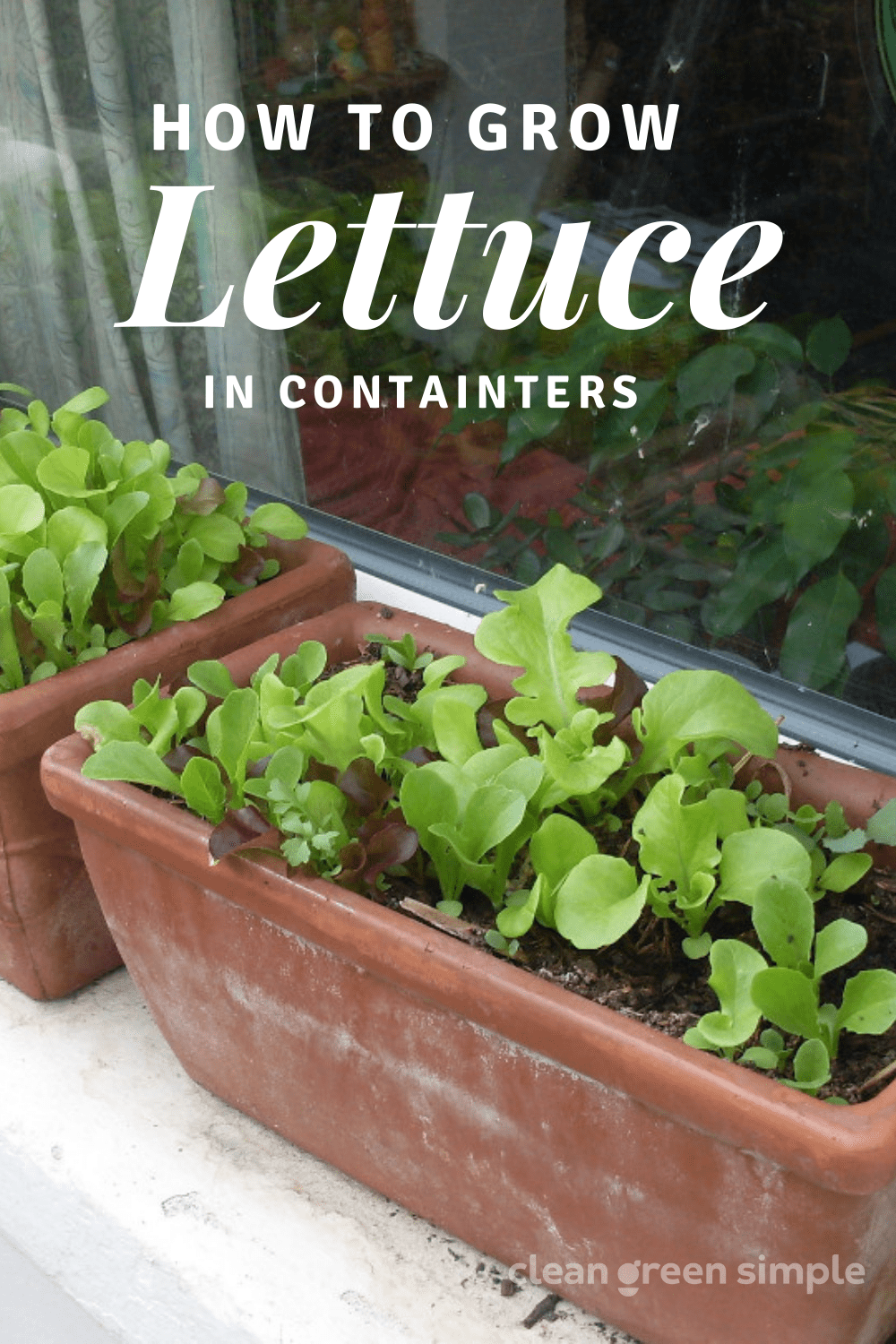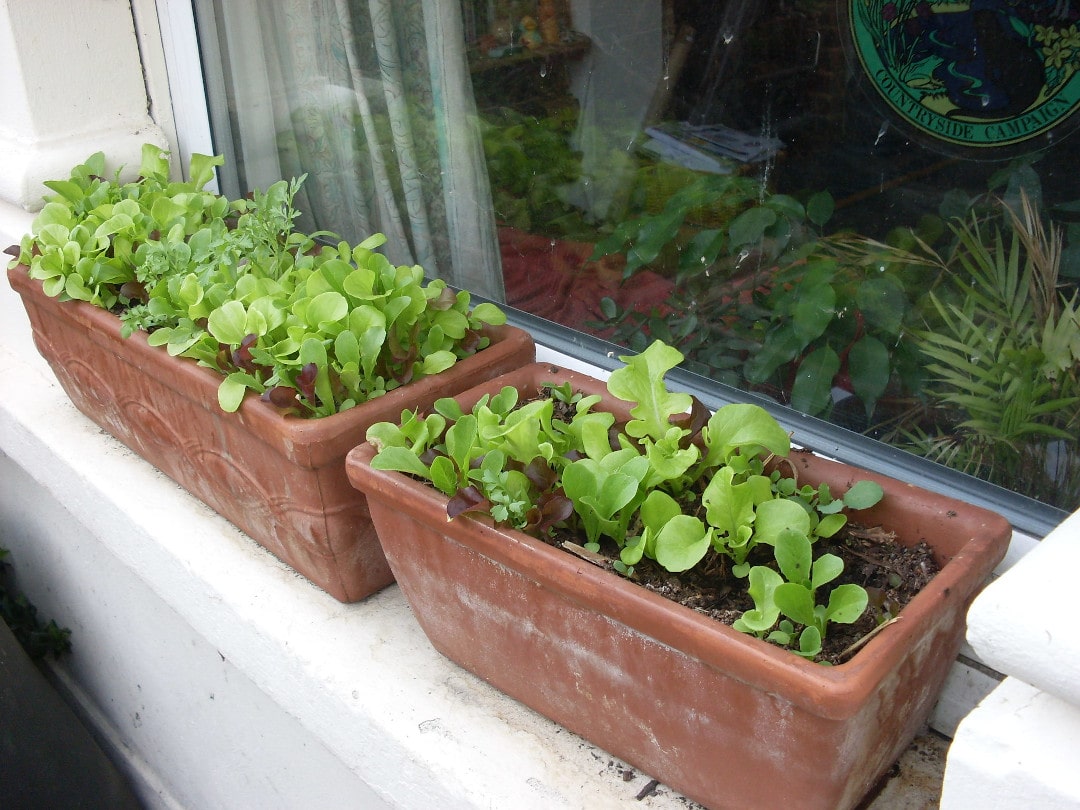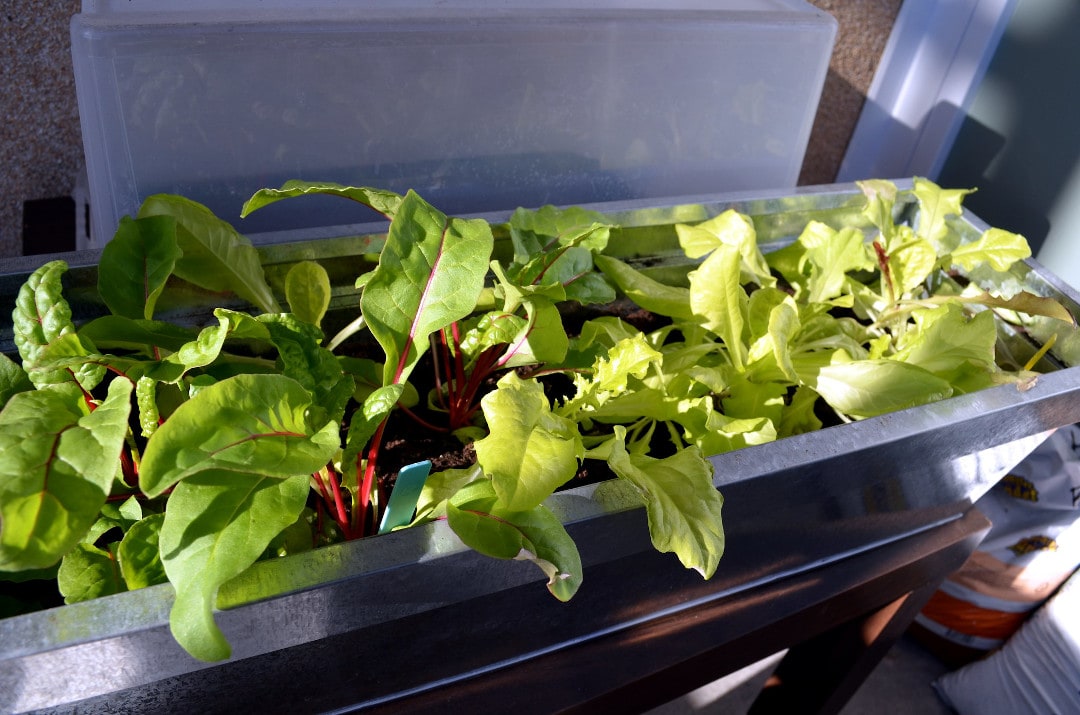Salad Bowl Cut and Come Again Letuce Warm Weather Lettuce for Caintainer Gardening
Eating your greens doesn't accept to mean breaking the bank. Let us prove you how to grow lettuce and greens in pots on your own patio using these 8 simple tricks.

Adding a healthy dose of salad greens to your diet is ane of the easiest ways to boost your nutritional intake.
Merely buying greens can be a hassle. The most nutritious varieties are absurdly expensive. And fifty-fifty those tend to rot afterward only a few days in the fridge (although a good herb keeper can brand them last longer).
Growing your own lettuce and salad greens is a keen alternative that can relieve you money and increase the variety of greens bachelor to you. And the best function? You can grow them at dwelling house fifty-fifty if you lot don't have a m or a garden.
In this article, nosotros'll evidence you how to grow lettuce in pots in eight simple steps. We'll also walk you through some common problems that crop up when growing in containers and how to handle them, plus some tips for using greens in the kitchen.
- The Advantages of Growing Lettuce In Containers
- Earlier Start to the Season
- Better Temperature Control
- Fewer Issues with Pests
- viii Helpful Tips for Growing Lettuce in Pots
- 1. Pick a Cool but Sunny Location
- 2. Observe a Pot that Maximizes Surface Area
- iii. Start with the Right Soil
- iv. Cull the Right Varieties
- five. Sow Your Seeds in Absurd Weather
- 6. Water Consistently
- 7. Harvest and Harvest Again
- eight. Keep an Center on the Temperature
- Common Problems You Might Face
- Get Your Greens On!
The Advantages of Growing Lettuce In Containers
Growing greens and lettuce in containers limits your growing space and harvest size. Simply this drawback is usually more than than made upward for by the many benefits that come with growing these vegetables in pots rather than in the ground.
Earlier Start to the Season
By growing your greens in containers, you tin easily extend your season by starting earlier.
Lettuce, spinach, and other delicate greens adopt growing in cool conditions. But in virtually climates, this means waiting until afterward the last hard frost to sow your seeds.
When using pots, yous have the option to bring your containers inside to plant your seeds to give them a head start. Once they have sprouted and matured some, and the threat of frost has passed, you tin can move them outdoors. While others are however waiting for their sprouts to abound in their gardens, you'll exist gear up to trim your first harvest.
In hotter climates, you can start your lettuce indoors for a fall crop. Past the time the sprouts have matured, the summertime temps will accept cooled enough to put the lettuce outside. By getting this head start, you'll get more than harvests in before the first hard frost.
Improve Temperature Control
The mobility of a container garden besides means you have more than power to control what temperatures your greens are exposed to throughout the growing season.
In the early spring and late fall, unexpected hard frosts can kill your lettuce. In the summertime, hot days encourage bolting which shortens the harvest period.
During these times, pots can exist moved inside to stay warm, or to absurd areas of the 1000 or patio to avoid getting boiled by the summer sun.
Fewer Issues with Pests
One of the hardest parts almost growing lettuce and greens is dealing with all the bugs that like to chomp on those delicate leaves.
Luckily, bugs are much less of an issue for container gardens.
The soil tin be completely replaced each spring, which means no bug with pests and their eggs overwintering. Plus, the plants are much less accessible for bugs that are passing through. Plants that are experiencing issues with pests tin can quickly be isolated to avoid the issue spreading to the entire crop, as well.

8 Helpful Tips for Growing Lettuce in Pots
Now that you know the many advantages of a lettuce container garden, here are some tips to help you create your ain.
1. Selection a Cool but Sunny Location
Almost all lettuce varieties and nearly greens are absurd flavor plants. This means they thrive when the average temperature is below 70 degrees.
This doesn't mean they don't similar sun, however. Six hours of light per day is adequate for most types, but more will help your plants mature faster.
When starting your garden in early leap, await for a spot that gets enough of southern exposure. As the season warms, you lot can motility your pots to an surface area that gets more morning time lite merely is spared from the called-for oestrus of the afternoon.
For greens started in the early fall, begin with the pots in that cooler eastern location and move them to the warmer, s-facing spot as the conditions cools.
2. Find a Pot that Maximizes Surface Expanse
Lettuces take fairly brusk root systems and but require nearly 6 inches of soil. Choosing a shallower, longer pot will give you more surface area, which means room to grow more plants.
Many greens, like spinach and kale, besides do well in these shallow, elongated pots. However, other blazon of greens, such as turnip and beet, require much more root space. For these types, choose a pot that's at to the lowest degree 12 inches deep.
Whichever pot y'all choose, ensure it has multiple drainage holes along the bottom to go on water from collecting effectually the institute'south roots.
three. Start with the Right Soil
Lettuce is 95% h2o, which means information technology requires near-constant admission to moisture to avert wilting. At the same time, it does not do well in standing water.
To encounter this balance of moist but non boggy, you need to fill your pot with a high-quality potting soil. This specialty soil holds onto moisture better than normal dirt while simultaneously allowing for quick drainage of excess h2o.
Fill your pots with potting soil then drench the soil in h2o. It may help to set up the pot in a dish or large tray and allow it to sit in h2o for a few hours. This volition encourage the soil to accept upward every bit much moisture equally possible before planting begins.
4. Choose the Right Varieties
At that place are plenty of lettuce and greens varieties to choose from. Some are improve suited to the restricted growth weather condition of containers than others. Here are a few of our favorite varieties:
- Rubygo Lettuce – A i-cut reddish leaf lettuce with a ton of flavour
- Verigo Lettuce – Exceptional flavor with a serrated leafage for ane-cut harvesting
- Dark-green or Cerise Oakleaf Lettuce – Delicate green or ruddy leaves for cut-and-come up-again harvesting
- Ruddy Romaine Lettuce – A archetype for salads that tin exist harvested in infant or mature class
- Arugula – Thick green leaves with a deep, near bitter flavor for adding graphic symbol to salads and burgers
- Kale – Comes in many varieties, all can be harvested in baby or mature form
- Spinach – Another classic that grows well in small spaces
- Chard – Requires more than space, just makes a groovy improver to homemade juices and is delicious when sauteed
Almost all varieties of lettuce can exist grown in containers. But loose leaf types tend to do better and crave less infinite than total-caput varieties. Some are meant to be grown to maturity and harvested only one time, while others tin be picked in infant-leaf class or harvested a few leaves at a time.
The term "greens" describes a broad range of different plant types, from root veggie leaves to familiar salad additions similar kale. Each blazon of green comes with its own special considerations and harvesting requirements.
five. Sow Your Seeds in Cool Weather
Most greens and lettuces do all-time when sowed straight into the pot they will be grown in.
To maximize your growing season, gear up your pots within side by side to a sunny window a few weeks before the last difficult frost in spring or a few weeks before the temps begin to drop in tardily summer.
If you plan to harvest your greens as "babe" leaves, simply sprinkle the seeds over moist soil, so gently agitate the soil to comprehend them. There is no demand to sparse in this case. Simply harvest the young leaves as needed.
If you program only to harvest mature heads, make a small indent most ¼ inch deep every few inches. Driblet a pinch of seeds in each pigsty and gently comprehend. Every bit the sprouts develop, thin co-ordinate to the package directions.
Lettuce seeds and many greens seeds need light to germinate, so be careful not to sow them also deep.
In one case the sprouts are a couple of inches tall and the risk of difficult frost or extreme heat has passed, you lot can movement the pot outside.
6. Water Consistently
Every bit your plants begin to grow, check the soil each twenty-four hour period. If it feels dry to the touch, add water. The drainage holes in the bottom of the pot should clinch the soil doesn't become over-saturated. If yous are using a saucer or tray under the pot, make certain to empty information technology of continuing water each day.
Greens and lettuce are like shooting fish in a barrel keepers and practise not require a lot of nutrients. As long as you started with a quality, fresh potting soil, you should not need to fertilize. If yous reuse the same soil for a fall harvest, add some liquid fertilizer before sowing your seeds.
vii. Harvest and Harvest Again
One of the best things about growing greens and lettuce is you can continue to harvest virtually varieties and they volition just keep growing.
For these "cut and come again" types, only snip off the outermost leaves every bit needed. The plants will continue to abound and aggrandize from the heart throughout the season.
Some lettuce types are best when harvested all at once toward the end of the season. For these, but cut off the entire head once the weather heats up or earlier the first hard frost of fall. Cut-and-come-again varieties should as well exist final-harvested in this manner.
8. Proceed an Eye on the Temperature
For fall harvests, go along an center out for frost warnings. Most lettuces and greens are hardy and tin withstand light frosts without problems. For lower temps, though, it is best to move the pots inside or practice a complete harvest and start again in the jump.
For spring crops, you will desire to look for signs of bolting.
When temperatures begin to warm and daylight increases, these plants will shift from producing leaves to producing flowers. When this happens, you will notice the center stalk begin to elongate. Once the flower stalk forms, the leaves become bitter and useable.
Doing a complete harvest is the but way to avert losing your crop once bolting begins. But to ward off bolting, yous can try moving your pots to a cooler location or setting upward a shade sail to lower the afternoon temperatures. These measures will help you extend your flavour past a few weeks.
Common Issues You Might Confront

Lettuce and greens are generally easy to grow, but several diseases and issues can affect their production. Here are some more than common bug you might experience when growing these leafy plants in pots.
- Failure to germinate – This happens most often considering the seeds were cached too deep. Make certain to merely embrace the seeds with a thin layer of dirt. Soil that is too warm tin can also crusade lettuce seeds not to germinate.
- Leaves that curl at the edges or are stunted – This is a common sign that your found has aphids. These tiny, fleshy bugs oftentimes feed on the underside and stems of greens and may not exist visible without some detective piece of work. Spraying leaves with soapy water tin can assistance remove and kill the bugs.
- Small-scale round holes in leaves – Many pests can cause this result, simply i of the most common perpetrators is the flea beetle. These tiny black, shiny, hopping bugs love arugula and other thick-leaved greens. Sprinkling infected plants with talcum pulverisation will help repel these pests.
- Snails and slugs – These slimy bugs beloved their greens. They are less of a trouble for container plants since these are more hard for them to admission. But if yous practise encounter them, try mulching your greens with red cedar bark to repel these slimy pests or fill a modest jar with beer and set it in the pot to attract and impale the bugs.
Keeping your container garden abroad from other ground plants and gardens will help reduce issues with pests. It is also a good idea to clean pots with soapy h2o and use fresh soil each flavour to avoid harboring eggs and larvae.
Become Your Greens On!
Now that you know how to grow your own greens, it'due south time to get creative in how you use them.
We all love a good archetype salad. Simply there are a lot more ways to utilize your harvest. Hither are a few of our favorite lettuce and green-centric recipes.
- Like shooting fish in a barrel Vegan Lettuce Wraps – Large-leafed lettuce makes the perfect boat for these tasty vegan wraps.
- Vegan Cobb Salad – Experiment with different combinations of lettuce and greens to wearing apparel this tasty salad.
- Vegan Portabella Burgers with Chipotle Mayo – This recipe calls for romaine, but substituting arugula quickly elevates this dish to the side by side level.
- Pesto and Ruby Pepper Sandwich – Any broad leafed lettuce volition work for this tasty lunch.
- Easy Vegan Pesto with Basil, Walnut and Kale – This outstanding pasta dish works with both baby and mature kale leaves.
Source: https://cleangreensimple.com/article/how-to-grow-lettuce-in-pots/
0 Response to "Salad Bowl Cut and Come Again Letuce Warm Weather Lettuce for Caintainer Gardening"
Post a Comment